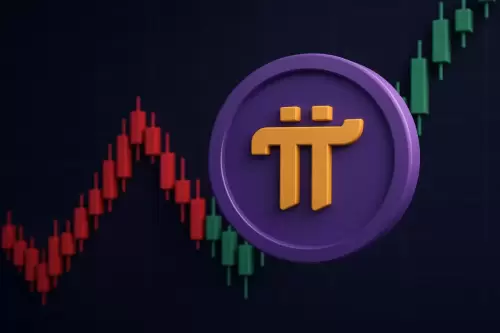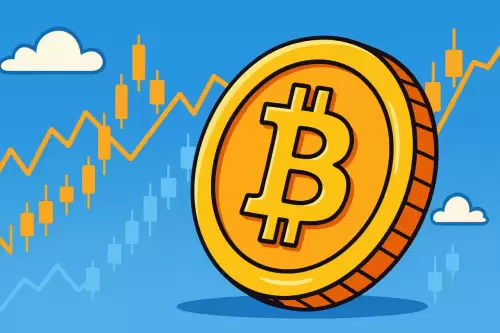 |
|
 |
|
 |
|
 |
|
 |
|
 |
|
 |
|
 |
|
 |
|
 |
|
 |
|
 |
|
 |
|
 |
|
 |
|
Nachrichtenartikel zu Kryptowährungen
Wenn Sie sich auf Ihre Bitcoin -Reise befassen, beginnt das Mastering, wie Sie diese bahnbrechende digitale Währung sicher speichern, senden und empfangen können.
May 21, 2025 at 05:09 pm
Eine Bitcoin -Brieftasche enthält keine Münzen wie ein traditionelles Bankkonto. Stattdessen verwaltet es Ihre privaten Schlüssel, die kryptografischen Geheimnisse, die Zugriff auf Mittel auf der Bitcoin -Blockchain gewähren.
Embarking on your Bitcoin journey begins with mastering how to securely store, send, and receive this groundbreaking digital currency. A Bitcoin wallet does not hold coins like a traditional bank account; rather, it manages your private keys, the cryptographic secrets that grant access to funds on the Bitcoin blockchain.
Wenn Sie sich auf Ihre Bitcoin -Reise befassen, beginnt das Mastering, wie Sie diese bahnbrechende digitale Währung sicher speichern, senden und empfangen können. Eine Bitcoin -Brieftasche enthält keine Münzen wie ein traditionelles Bankkonto. Vielmehr verwaltet es Ihre privaten Schlüssel, die kryptografischen Geheimnisse, die Zugriff auf Mittel auf der Bitcoin -Blockchain gewähren.
Choosing the right wallet model and understanding its mechanics will ensure both security and convenience as you navigate the world of Bitcoin transactions.
Durch die Auswahl des richtigen Brieftaschenmodells und des Verständnisses seiner Mechanik wird sowohl Sicherheit als auch Komfort sichergestellt, wenn Sie die Welt der Bitcoin -Transaktionen navigieren.
Understanding Bitcoin Wallets
Bitcoin -Brieftaschen verstehen
At its core, a wallet is software or hardware that safely stores your private key and derives a public key (and corresponding address) for receiving bitcoin. When you create a wallet, it generates a unique seed phrase, typically 12 or 24 words that encapsulates all future private keys. This seed must be backed up offline on non-digital media (such as engraved metal or secure paper) and stored in separate, safe locations. Losing the seed phrase means losing access to your funds, while exposing it allows anyone to spend your bitcoin.
In seinem Kern ist eine Brieftasche Software oder Hardware, die Ihren privaten Schlüssel sicher speichert und einen öffentlichen Schlüssel (und eine entsprechende Adresse) zum Empfangen von Bitcoin ableitet. Wenn Sie eine Brieftasche erstellen, erzeugt sie eine eindeutige Saatgutphrase, typischerweise 12 oder 24 Wörter, die alle zukünftigen privaten Schlüssel zusammenfassen. Dieser Saatgut muss auf nicht digitalen Medien (z. B. eingraviertes Metall oder sicheres Papier) offline gesichert und an getrennten, sicheren Orten gespeichert werden. Wenn Sie den Samenphrase verlieren, verlieren Sie den Zugang zu Ihren Mitteln und ermöglicht es jedem, Ihr Bitcoin auszugeben.
Storing, Sending, and Receiving Bitcoin
Bitcoin speichern, senden und empfangen
Storing BTC
BTC speichern
Once your wallet is set up, generating a receiving address is as simple as clicking “Receive” in your wallet interface. This will display a unique alphanumeric string, which is your bitcoin address. Treat this address like a bank account number for bitcoin deposits. Always verify the address on your device (for hardware wallets) before sharing it, and never reuse addresses for multiple transactions to enhance privacy.
Sobald Ihre Brieftasche eingerichtet ist, ist das Erstellen einer Empfangsadresse so einfach wie das Klicken auf „Empfangen“ in Ihrer Brieftaschenschnittstelle. Dadurch wird eine eindeutige alphanumerische Zeichenfolge angezeigt, die Ihre Bitcoin -Adresse ist. Behandeln Sie diese Adresse wie eine Bankkontonummer für Bitcoin -Einlagen. Überprüfen Sie immer die Adresse auf Ihrem Gerät (für Hardware -Geldbörsen), bevor Sie sie teilen, und verwenden Sie niemals Adressen für mehrere Transaktionen, um die Privatsphäre zu verbessern.
Sending BTC
BTC senden
To send bitcoin, input the recipient’s address and specify the amount. Software wallets will sign the transaction automatically if the key resides locally, while hardware wallets prompt you to verify details and press a physical button on the device, ensuring no unauthorized changes occur. After signing, the wallet broadcasts the transaction to network nodes miners , who will validate and include it in the next block. Transaction fees fluctuate with network congestion, so you may choose to adjust fees for faster confirmation or cost savings.
Um Bitcoin zu senden, geben Sie die Adresse des Empfängers ein und geben Sie den Betrag an. Software -Brieftaschen signieren die Transaktion automatisch, wenn sich die Taste lokal befindet, während Hardware -Geldbörsen Sie auffordern, Details zu überprüfen und eine physische Taste auf dem Gerät zu drücken, um sicherzustellen, dass keine nicht autorisierten Änderungen auftreten. Nach der Unterzeichnung überträgt die Brieftasche die Transaktion zu Netzwerkknoten, die sie validieren und in den nächsten Block aufnehmen. Transaktionsgebühren schwanken mit Netzwerküberlastungen, sodass Sie Gebühren für eine schnellere Bestätigung oder Kosteneinsparungen anpassen können.
Receiving BTC
BTC erhalten
Receiving bitcoin simply involves providing your public address. Once the sender submits the transaction, it will typically appear immediately after the first block in your wallet with one confirmation, though waiting for three to six confirmations is recommended for larger amounts to guard against chain reorganizations or double-spend attempts.
Bitcoin erhalten einfach die Angabe Ihrer öffentlichen Adresse. Sobald der Absender die Transaktion eingereicht hat, wird er normalerweise unmittelbar nach dem ersten Block in Ihrer Brieftasche mit einer Bestätigung angezeigt, obwohl das Warten auf drei bis sechs Bestätigungen für größere Beträge empfohlen wird, um sich gegen Kettenrekongationen oder doppelte Versuche zu schützen.
Different Categories of Wallet Models
Verschiedene Kategorien von Brieftaschenmodellen
Choosing the right wallet depends on your personal use case:
Die Auswahl der rechten Brieftasche hängt von Ihrem persönlichen Anwendungsfall ab:
A software wallet runs on an Internet-connected device and offers features like in-app trading, price alerts, and dApp integrations. While highly convenient for daily transactions, it exposes your keys to online risks and demands rigorous device security practices, including frequent updates and antivirus protection.
Eine Software-Brieftasche läuft auf einem mit Internet verbundenen Gerät und bietet Funktionen wie In-App-Handel, Preiswarnungen und DAPP-Integrationen. Obwohl es für tägliche Transaktionen sehr bequem ist, setzt es Ihre Schlüssel den Online -Risiken aus und erfordert strenge Sicherheitspraktiken der Geräte, einschließlich häufiger Aktualisierungen und Antivirenschutz.
A cold wallet often a paper backup or an air-gapped computer ensures your keys are never touched by a networked device. This model provides the highest isolation for long-term storage but requires extra steps each time you want to move funds, such as transferring signed transactions via USB or QR code.
Eine kalte Brieftasche oft eine Papiersicherung oder ein luftgesteckter Computer stellt sicher, dass Ihre Schlüssel nie von einem vernetzten Gerät berührt werden. Dieses Modell bietet die höchste Isolation für den Langzeitspeicher, erfordert jedoch bei jedem USB- oder QR-Code zusätzliche Schritte, wenn Sie Mittel verschieben, z.
A hardware wallet, such as those from Ledger, combines the advantages of both: private keys are generated and for most of them stored in a certified Secure Element chip offline, while on-device transaction signing preserves security without sacrificing usability. These devices support a wide range of cryptocurrencies and integrate seamlessly with popular software interfaces. A hardware wallet functions as a cold wallet whenever it is kept offline.
Eine Hardware-Brieftasche wie die von Ledger kombiniert die Vorteile beider: Für die meisten von ihnen werden in einem zertifizierten sicheren Element-Chip offline gespeichert, während die Signiertelung bei On-Device-Transaktionen die Sicherheit bewahrt, ohne die Benutzerfreundlichkeit zu beeinträchtigen. Diese Geräte unterstützen eine Vielzahl von Kryptowährungen und integrieren nahtlos in beliebte Software -Schnittstellen. Eine Hardware -Brieftasche fungiert als kalte Brieftasche, wenn sie offline aufbewahrt wird.
Verified Advantages of Ledger Hardware Wallets
Überprüfte Vorteile von Brieftaschen von Hauptbuchhardware
By understanding how wallets handle private keys and selecting a model with verifiable security credentials such as a Ledger hardware wallet, you can manage your bitcoin holdings confidently, protecting your assets while participating fully in the cryptocurrency ecosystem.
Wenn Sie verstehen, wie Brieftaschen mit privaten Schlüssel umgehen und ein Modell mit überprüfbaren Sicherheitsanmeldeinformationen wie einer Brieftasche von Ledger -Hardware auswählen, können Sie Ihre Bitcoin -Bestände sicher verwalten und Ihre Vermögenswerte schützen und gleichzeitig vollständig am Kryptowährungs -Ökosystem teilnehmen.
Haftungsausschluss:info@kdj.com
Die bereitgestellten Informationen stellen keine Handelsberatung dar. kdj.com übernimmt keine Verantwortung für Investitionen, die auf der Grundlage der in diesem Artikel bereitgestellten Informationen getätigt werden. Kryptowährungen sind sehr volatil und es wird dringend empfohlen, nach gründlicher Recherche mit Vorsicht zu investieren!
Wenn Sie glauben, dass der auf dieser Website verwendete Inhalt Ihr Urheberrecht verletzt, kontaktieren Sie uns bitte umgehend (info@kdj.com) und wir werden ihn umgehend löschen.
-

-

-

- Überzeugung, Justizsystem und Morde: Ein Blick auf die jüngsten Fälle und die Verschiebung der Perspektiven
- Jul 26, 2025 at 06:00 pm
- Untersuchung der Komplexität der Überzeugung im Lichte neuer Beweise, Vorschriften und des historischen Kontextes. Von der Krypto bis zum Verbrechen steht die Gerechtigkeit gegenüber der Prüfung.
-

-

-

-

-

-




























































